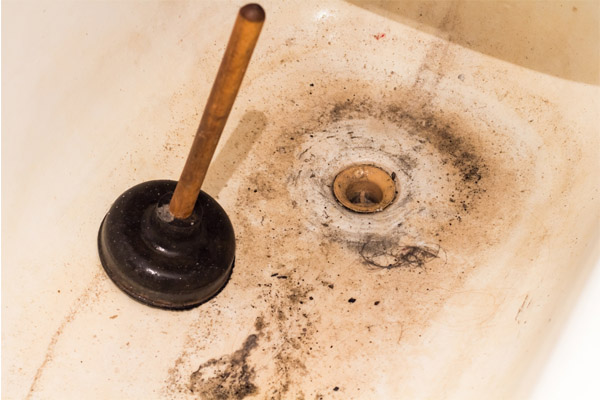Revealing the Causes of Waste in the Bathtub
Revealing the Causes of Waste in the Bathtub
Blog Article
Were you trying to locate answers concerning Water Coming up Bathtub Drain?

Sewage back-up in the tub can be an upsetting and unhygienic problem for any kind of property owner. Not only is it inconvenient, yet it additionally presents serious wellness dangers and indicates underlying problems with the plumbing system. Comprehending why sewage is turning up through the bathtub is critical for taking suitable activity to attend to the issue efficiently.
Introduction to the Issue
Usual Factors for Sewage Backup
Obstructions in the Sewage System Line
Among one of the most typical causes of sewer backup is an obstruction in the sewer line. This can take place because of the build-up of debris, grease, or international objects in the pipelines, protecting against appropriate circulation and causing sewage to back up into your tub.
Tree Origin Invasion
Tree origins looking for moisture and nutrients can penetrate drain lines via small splits or joints. With time, these origins can grow and expand, creating significant damages to the pipelines and bring about sewer back-up issues.
Understanding the Trouble
When sewage draws back up into the bathtub, it's a clear indication of a trouble with the water drainage system. The wastewater that ought to be streaming far from your home is rather discovering its way back into your home, which can result in considerable damage and carcinogen.
Prospective Causes
Several factors can add to sewage backup in the bath tub. From blockages in the drain line to issues with the plumbing facilities, identifying the origin is necessary for finding a remedy.
Aging Facilities
Older homes may have outdated plumbing systems that are a lot more at risk to corrosion, fractures, and wear and tear. As pipelines age, they come to be much more prone to leaks and blockages, increasing the chance of sewer backup events.
Heavy Rainfall or Flooding
During durations of heavy rainfall or flooding, the sewer system might end up being overwhelmed with excess water, triggering back-ups and overflows. This can cause sewage backing up into bath tubs and other fixtures inside the home.
Signs of Sewer Backup
Foul Odors
Unpleasant odors emanating from drains pipes or components, particularly in the restroom, might show sewage back-up concerns. These smells are often solid and persistent, signaling a problem that calls for immediate attention.
Slow Draining Fixtures
Bathtubs, sinks, and bathrooms that drain pipes slowly or not whatsoever could be experiencing sewage back-up. If numerous fixtures are impacted all at once, it's likely that the problem stems from a common point, such as the major sewer line.
Gurgling Noises
Unusual gurgling or gurgling noises coming from drains when water is running in other places in your house are a measure of air entraped in the plumbing system. This air accumulation can result from sewer backup and need to be explored without delay.
Wellness Risks Connected With Sewer Back-up
Contamination of Water Supply
Sewage backup can pollute the water supply in your house, positioning a serious wellness danger to you and your household. Direct exposure to contaminated water can bring about stomach issues, skin infections, and other ailments.
Mold and mildew Development
Moisture from sewage backup can create optimal problems for mold growth in your house. Mold and mildew spores can exacerbate respiratory problems and cause allergies in delicate people, making timely cleaning necessary.
Spread of Illness
Sewage includes harmful germs, viruses, and bloodsuckers that can trigger a series of illness, including liver disease, cholera, and gastroenteritis. Entering contact with sewage or polluted surface areas places you in jeopardy of infection.
Tidying up After Sewer Backup
Sanitation Procedures
Completely sanitize and sterilize affected locations after sewage back-up to eliminate harmful bacteria and avoid mold and mildew growth. Use proper cleansing items and safety gear to make certain risk-free and effective clean-up.
Repair of Affected Areas
Repair any type of damage to flooring, walls, or components brought on by sewer back-up. Relying on the level of the damages, you might require to change carpeting, drywall, or various other products to recover your home to its pre-loss condition.
Immediate Actions to Take
Switching Off Water Supply
In case of sewage back-up, it's essential to shut off the water system to prevent additional contamination and damage. Situate the major water shutoff valve in your home and shut it off till the issue can be solved.
Getting In Touch With an Expert Plumber
Handling sewer backup is not a DIY work. Get in touch with a qualified plumber with experience in handling sewage-related concerns to analyze the scenario and execute required repairs or clean-ups.
Avoiding Contact with Polluted Water
Until the sewage backup is solved, stay clear of contact with polluted water to stop the spread of bacteria and microorganisms. Put on safety equipment if you must be in the afflicted area and wash your hands thoroughly later.
Safety nets
Regular Upkeep of Sewer Lines
Arrange normal evaluations and maintenance of your sewer lines to identify and resolve potential problems before they intensify right into significant issues. This can include cleaning particles, inspecting for tree origin intrusion, and repairing any damaged pipelines.
Installing Backwater Shutoffs
Take into consideration setting up bayou shutoffs in your plumbing system to prevent sewage from flowing back right into your home during periods of heavy rainfall or flooding. These valves instantly close when water starts backing up, protecting your building from contamination.
Correct Disposal of Household Waste
Avoid purging anything other than toilet paper and human waste down the commode to stop blockages and obstructions in the sewer line. Dispose of grease, oil, and other family chemicals appropriately to reduce the risk of plumbing issues.
Why Is Water Backing Up in My Bathtub When I Flush My Toilet?
What to do about a sewer line clog
First, don’t bother with plunging. No amount of plunging will dislodge the clog in a sewer line. The clog is too far away. Plungers are for clogs in the toilet itself, not the sewer line. Plus, the most likely causes of a sewer clog are:
Tree roots Flushed toys or feminine products Grease buildup Those items don’t move easily. And in the case of tree roots, the roots need to be cut out of the pipe and the pipe will need to be repaired.
You’ll need a closet auger. A closet auger is a type of plumber’s snake with a protective cover to keep from scratching the delicate porcelain toilet. If the clog is further down, you may need to remove the toilet or use one of your cleanouts to get to the clog.
We also recommend doing a video inspection of the drain to ensure that the cause of the clog has been completely removed. Otherwise, you could have the same problem again in a few days or weeks.
https://mspplumbingheatingair.com/blog/why-is-water-backing-up-in-my-bathtub-when-i-flush-my-toilet

I found that post about Why is Sewage Backing Up Into My Bathtub? when doing research the web. Those who liked our blog entry kindly consider to share it. Many thanks for going through it.
Call Today
Report this page